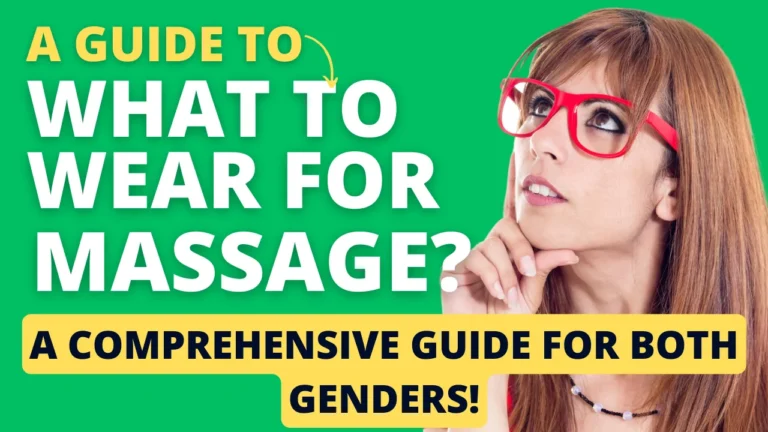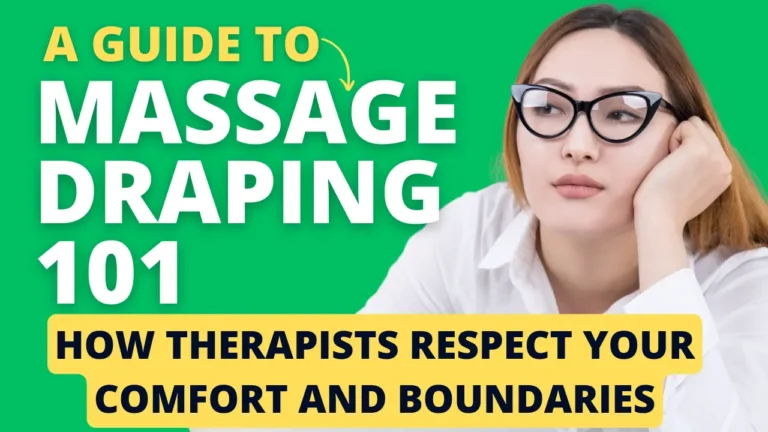In this Blog Post on “Can You Get a Massage if You are Overweight?” you’ll discover:
- Common concerns of overweight individuals considering a massage.
- The array of benefits that massage therapy offers for those with diverse body types.
- The crucial role of effective communication with your massage therapist.
- Tips for choosing the right therapist who understands and respects your unique needs.
- Specific massage techniques and adjustments that ensure a comfortable and enjoyable experience.
- Essential safety considerations for a worry-free massage session.
So, get ready to uncover how massage therapy can be a source of relaxation, comfort, and rejuvenation, no matter your body size. Let’s dive in!
Quick Answer to Can A Fat Person Get A Massage?
Absolutely, you can get a massage if you’re overweight, and it can be an immensely beneficial and enjoyable experience. The key lies in effective communication with your therapist, choosing the right professional who understands your needs, and being aware of safety considerations. Massage therapy offers stress relief, improved circulation, pain management, and a host of other benefits that cater to individuals of all body types. So, don’t let concerns hold you back—embrace massage therapy as a valuable tool for self-care and well-being, regardless of your size.
Jump To:
The Concerns of the overweight individuals
Many overweight individuals have legitimate concerns or uncertainties when it comes to getting a massage.
Let’s address some of these common worries:
1. Feeling Self-Conscious
- It’s natural to feel self-conscious about your body, especially in a vulnerable setting like a massage. However, professional massage therapists are trained to be non-judgmental and create a safe, welcoming space for all body types.
2. Physical Discomfort
- You might be concerned that your weight could make the massage uncomfortable. Rest assured, therapists are skilled in adjusting pressure and techniques to ensure your comfort.
3. Health Conditions
- If you have underlying health conditions related to your weight, you may wonder if massage is safe. We’ll explore safety considerations later in this article, but it’s essential to communicate your medical history with your therapist.
4. Finding the Right Therapist
- Finding a therapist who understands your unique needs is crucial. We’ll provide tips on how to choose the right massage therapist who specializes in working with diverse body types.
5. Uncertainty About Benefits
- You might question whether massage can truly benefit you. We’ll delve into the specific advantages of massage for overweight individuals in the following sections.
It’s essential to remember that these concerns are valid, but they shouldn’t deter you from experiencing the many benefits of massage. Professional therapists are here to address your worries and provide you with a relaxing and rejuvenating experience.
Benefits of Massage for Overweight Individuals
Now that we’ve acknowledged some common concerns, let’s delve into the reasons why massage can be incredibly beneficial for individuals who are overweight.
Here are the key advantages:
1. Stress Relief
- Weight-related stress can take a toll on both your body and mind. Massage therapy is renowned for its stress-relieving properties. It can help reduce cortisol levels, promoting relaxation and overall well-being.
2. Improved Circulation
- Carrying excess weight can sometimes impede blood circulation. Massage techniques, such as effleurage and petrissage, can stimulate blood flow, enhancing oxygen and nutrient delivery to your tissues.
3. Pain Management
- Overweight individuals may experience joint pain, muscle tension, or back discomfort due to the extra strain on their bodies. A skilled massage therapist can target these specific areas, providing relief from pain and tension.
4. Enhanced Body Awareness
- Massage can improve your body awareness, helping you better understand your body’s needs and sensations. This can lead to more mindful choices when it comes to diet and exercise.
5. Positive Body Image
- Regular massages can contribute to a more positive body image. As you experience the nurturing touch of a therapist, you may come to appreciate and accept your body more, regardless of its size.
6. Boosted Mood
- Massage can release endorphins, the body’s natural feel-good hormones. This can lead to an improved mood and a greater sense of well-being, which can be especially valuable if you’re dealing with weight-related emotional challenges.
7. Better Sleep
- Many individuals who are overweight struggle with sleep issues. Massage can promote relaxation and help alleviate sleep problems, leading to more restful nights.
By now, you can see that massage therapy offers a range of benefits that are not only accessible but tailored to the needs of those carrying extra weight. These advantages extend far beyond relaxation, making massage a valuable tool in your journey toward improved health and well-being.
How To Communicate with Your Massage Therapist When Overweight
Effective communication with your massage therapist is key to ensuring a positive and comfortable experience.
Here’s why it matters and how to go about it:
1. Discussing Concerns and Preferences
- Start by openly sharing any concerns or questions you have with your therapist. This might include worries about your body, specific areas of tension, or any medical conditions related to your weight.
2. Tailoring the Massage to Your Needs
- Your therapist can customize the massage to address your unique requirements. Whether you prefer lighter pressure or have specific areas that need attention, communicating your preferences ensures you get the most out of your session.
3. Understanding Boundaries
- Establishing boundaries is essential for your comfort. Let your therapist know if there are areas you’d rather not have massaged, or if you have any sensitivities.
4. Feedback During the Massage
- During the session, don’t hesitate to provide feedback. If something doesn’t feel right or if you want adjustments in pressure or technique, your therapist will appreciate your input.
5. Trust the Professional
- Remember that your massage therapist is trained to provide a safe and enjoyable experience. Trust in their expertise and knowledge to guide you through the session.
Effective communication fosters a collaborative and comfortable atmosphere, ensuring that your massage experience is tailored to your needs and preferences. It’s a two-way street, and by sharing openly, you’ll maximize the benefits of your massage session.
Best Massage Techniques for Overweight Clients
When it comes to massage techniques for individuals who are overweight, it’s essential to focus on comfort and effectiveness.
Here are some massage techniques that are particularly well-suited for those with diverse body types:
1. Swedish Massage
- Swedish massage uses long, gliding strokes and gentle kneading to promote relaxation and improve circulation. This technique can be adapted to provide a soothing and comfortable experience.
2. Deep Tissue Massage
- Deep tissue massage is effective for addressing muscle tension and pain. Your therapist can adjust the pressure to your comfort level, ensuring that it is both therapeutic and comfortable.
3. Shiatsu
- Shiatsu, a form of Japanese massage, involves applying pressure to specific points on the body. It can help relieve tension and improve energy flow without requiring you to disrobe, which can be a preference for some clients.
4. Chair Massage
- Chair massage is an excellent option for those with difficulty lying down for extended periods. You can remain seated and fully clothed while enjoying a rejuvenating massage.
5. Myofascial Release
- Myofascial release releases tension in the fascia, the connective tissue surrounding muscles. It can be especially beneficial for those with chronic pain or limited mobility.
6. Aromatherapy
- Aromatherapy involves using scented oils to enhance relaxation and provide a sensory experience during the massage. Your therapist can select scents that resonate with you to create a calming atmosphere.
7. Hydrotherapy
- Hydrotherapy may include the use of warm water treatments to relax muscles and soothe the body. This can be particularly effective for individuals with joint pain or stiffness.
Remember that your massage therapist will adapt these techniques to your specific needs and comfort level. Communication is key, so don’t hesitate to provide feedback during the session to ensure you have the best possible experience.
Massage Positioning and Comfort for Overweights
Ensuring your comfort during a massage, regardless of your body size, is a top priority for skilled therapists. Here’s how they can make adjustments to positioning and support to enhance your overall comfort:
1. Bolsters and Pillows
- Massage therapists often use bolsters and pillows to provide extra support and alignment during the massage. These can be strategically placed under your knees, ankles, or neck to reduce pressure on specific areas.
2. Specialized Tables
- Some massage facilities offer specialized tables with wider cushions and sturdy support. These tables are designed to accommodate clients of all body types comfortably.
3. Side-Lying Position
- Therapists can use a side-lying position if lying face-down is uncomfortable due to your body size. This allows for a relaxing massage while minimizing discomfort.
4. Adjustable Pressure
- Your therapist will continuously adjust the pressure and technique based on your feedback. Tell them if anything doesn’t feel right, and they’ll immediately adjust.
5. Blankets and Draping
- Blankets and proper draping techniques ensure that you feel secure and covered throughout the massage, enhancing your comfort and sense of privacy.
6. Choice of Oils
- You can choose massage oils or lotions that you find most appealing and soothing. Your therapist will accommodate your preferences when selecting products.
By making these simple yet effective adjustments, your massage therapist can ensure that you’re relaxed and at ease throughout the session. Remember that massage therapy aims to provide a positive and nurturing experience, and these accommodations are standard practice to achieve that.
Massage Safety Considerations for Overweights
Safety is paramount during a massage, and there are specific considerations that both you and your therapist should keep in mind to ensure a safe and comfortable experience:
1. Health History
- Be sure to share your complete health history with your therapist, including any medical conditions, medications, or recent surgeries. This information helps your therapist tailor the massage to your specific needs and avoid potential contraindications.
2. Allergies and Sensitivities
- If you have allergies or sensitivities to certain products or scents, inform your therapist beforehand to avoid any adverse reactions during the massage.
3. Joint Health
- Overweight individuals may be at a higher risk of joint issues. Communicate any joint pain or discomfort, as your therapist can adjust techniques and pressure accordingly.
4. Blood Pressure
- Some massage techniques can affect blood pressure. If you have hypertension or are on medication to manage blood pressure, discuss this with your therapist so they can modify the session appropriately.
5. Breathing and Comfort
- Pay attention to your comfort during the massage. If you experience difficulty breathing or discomfort in any position, communicate this immediately. Your therapist can make adjustments to ensure your safety.
6. Hydration
- Staying hydrated before and after a massage is important. Drinking water can help flush out toxins released during the massage and prevent dehydration.
7. Post-Massage Care
- After your massage, take some time to rest and allow your body to adjust. Avoid heavy meals, alcohol, or strenuous activity immediately following the session.
By considering these safety factors, you and your therapist can work together to ensure that your massage experience is both relaxing and free from any potential risks. Remember that open communication is key to addressing any concerns or issues that may arise during the session.
FAQs
Should a fat person be hesitant to visit a massage therapist?
No, a fat person should not be hesitant to visit a massage therapist. Massage therapists are trained professionals who are experienced in working with clients of all body types and sizes. They are committed to providing a comfortable and non-judgmental environment for their clients.
Will a Massage Therapist be Disgusted by Me if I’m Fat?
None of the massage therapists will be disgusted by a client who is fat or of any body size. Professional massage therapists are trained to treat all clients with respect and dignity and without discrimination. we focus on the well-being and relaxation of our clients, regardless of their body size. It is important for clients to feel comfortable and safe during a massage, and a good massage therapist will create a welcoming and inclusive atmosphere for all clients.
Final Thoughts on Can You Get a Massage if You Are Overweight
So the Answer to “Can You Get a Massage if You are Overweight?” is a resounding “yes!” Massage therapy can be an incredibly beneficial and enjoyable experience for individuals of all body types, including those who are overweight.
It’s essential to remember that your body size should never be a barrier to self-care and relaxation. Skilled massage therapists are here to support you, listen to your concerns, and provide a customized experience that promotes your well-being.
So, if you’ve been hesitant about trying a massage because of your weight, I encourage you to take that step toward self-care and rejuvenation. Finding the right therapist and openly communicating your needs will lead to a rewarding and comfortable experience.






